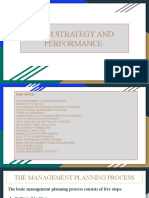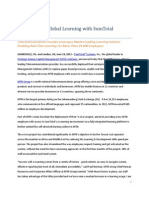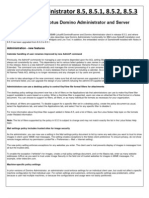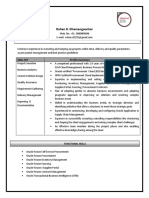1
Whitepaper
Improving Employee Engagement to Drive Business Performance
A New Strategic Wave
The Employee Engagement Revelation
Executive leaders and human resources (HR) practitioners are more frequently recognizing the importance of an engaged workforce and its potential to drive business performance and impact the bottom line. Engaged employees are people that are highly motivated and vested in the success of their organizations and are willing to make an extra, discretionary effort in their daily work. Academics, consultants, psychologists, and even financial analysts have written much on the subject of employee engagement during the past fifteen years. Most of their focus has been on what drives engagement, with empirical research identifying several factors. These factors range from the employee-manager relationship, to a challenging work environment, a company’s focus on customers, outstanding performance recognition, and career development opportunities. By understanding the most important factors that drive engagement, HR leaders are able to develop effective engagement programs. A more compelling outcome of engagement research, however, shows that an engaged workforce impacts business performance, and ultimately, shareholder value. Put simply, companies with higher percentages of engaged employees perform better than their industry peers. Indeed, researchers at the CIPD, Gallup, and Towers Watson have validated the impact of employee engagement and HR best practices on business performance.To summarize, companies with more engaged employees have:


2
Improving Employee Engagement To Drive Business Performance
Equally interesting, financial analysts have taken notice. For instance, a recent equities report focused on a large international bank cited that employee engagement scores are highly correlated with shareholder returns. Further, the report highlighted that the engagement score difference between the bank and its nearest competitor is costing the bank approximately 26 Million USD additional profits per year. As a result, the financial analyst downgraded the bank’s stock.Given the mounting evidence, it should come as no surprise that CEOs, CFOs, and senior HR officials are taking serious notice of employee engagement. Companies that fail to engage their staff face significant risks – including financial ones – relative to their competitors that have established systematic engagement strategies.
Demand Increasing for Talent management
In a 2010 study by SumTotal across 300 global organizations, 59% of HR practitioners indicated that their personnel were not adequately prepared to meet their companies’ future goals, a perception that has been on the rise for several years. This alarming trend has created a sense of urgency among organizations to develop holistic talent management strategies.Leaders in all business functions – including CxOs, HR practitioners, and line-of-business managers – need accurate and accessible workforce information to make the right decisions to support their business objectives. To provide this level of visibility, organizations are integrating their HR processes and information into holistic talent management systems. These systems encompass numerous strategic HR processes that enable companies to effectively plan, hire, align, develop, reward, manage, and analyze a high-performing workforce. The goals of talent management are straightforward – hire great people, ensure they are properly trained, align their goals to corporate strategy, reward top performance, and provide timely motivation to retain the best employees.
Improving Employee Engagement With Talent management
Since employee engagement has a direct impact on business performance and the bottom line, leading companies are developing talent management business cases focused on improving engagement. These business cases typically encompass current processes, business requirements, gap analyses, system/technology needs, and change management considerations. Furthermore, several core talent management processes directly impact employee engagement (see table on the next page). As a part of their business cases, companies should map these standard talent management processes to their most pressing engagement challenges. This analysis facilitates deeper understanding of core requirements, and also helps with the provisioning and prioritization of talent management software.
Have the right information easily accessible in order to make the right decisions
STRATEGY
on ti
gr nt e i at o
ut A ta da ee oy pl ical it
ri f c o
STRATEGY
3
Talent management ProcessDescriptionImpact on Employee Engagement
Workforce Planning Plans, schedules, budgets, tracks, and allocates employee resourcesEngaged employees require the proper resources to effectively execute their jobsTalent Acquisition (Recruiting and Hiring)Streamlines the entire hiring lifecycle from requisition to candidate selectionEnsures the “right” person is hired and possesses the required job competencies to be successfulSuccession Planning Identifies, prepares, and tracks high potential employees for promotionCareer advancement opportunities are a top driver of employee engagementCareer DevelopmentProvides competency-based development and career plansEmpowers employees to take an active interest in their own developmentCompensation ManagementSimplifies and standardizes the planning, modeling, budgeting, analysis, and execution of global compensation and reward policiesEngaged employees require fair, equitable, and consistent compensation practices; Strong performers must be rewarded appropriatelyIncentive CompensationMotivates employees and manages financial rewards within an organizationPay-for-performance is a strong motivator (and strong performers must be rewarded)Performance ManagementOptimizes performance management processes and aligns employee development and goals with corporate objectivesEmployee goals are clearly articulated and workers have a better understanding of how their efforts impact the company (line-of-sight visibility)Learning ManagementAutomates and manages employee learning and trainingThe company is actively investing in employee learning and skills development360 FeedbackAutomates the entire 360 coaching and personnel development processConsistent feedback and resulting development plans drive employee growth HR Management (HRMS)Centralizes, consolidates, and integrates HR informationEmployees have a centralized, consistent way of managing their talent profiles (which impacts areas like succession planning)Workforce AnalyticsProvides real-time analysis of workforce metrics and key performance indicatorsHR practitioners can continuously monitor and tweak employee engagement programs; Engagement can be tied to bottom-line business outcomes
Improving Employee Engagement To Drive Business Performance
4
The Role of Talent management Software
Enterprise software is playing an increasingly vital role in enabling talent management business strategies. It is also helping to facilitate HR’s transformation and corporate ascension as a more strategic, boardroom-level “player.” What is making this possible is a (seemingly) simple concept: integration.Most companies suffer from disjointed HR processes and scattered employee infor-mation across silos of files, spreadsheets, and systems. Compounding this challenge, siloed software implementations (e.g., separate systems for recruiting, performance assessment, compensation administration, learning, core HRMS) often fragment the very data that enables more accurate reporting and improved decision-making. To circumvent these integration challenges, many companies are disbanding their legacy point solutions and moving toward a single, natively-integrated talent management software platform to meet their requirements. At the core of this integrated platform is the employee system of record. This record includes employee data, talent profiles, job profiles, on-boarding best practices, and competencies. All of this information, once made consistent across the organization, feeds your critical HR business processes, facilitates the linkages across these processes, and ultimately enables improved business analysis, insight, and decision making.While talent management software will not solve all of the employee engagement challenges companies may face (e.g., improving the personal relationship between an employee and manager), there are many benefits of a single talent management platform:Link all elements of the employee lifecycle, from hiring
■
through retirementEnsure company-wide consistency of HR information
■
and processes
Improving Employee Engagement To Drive Business Performance




































































































